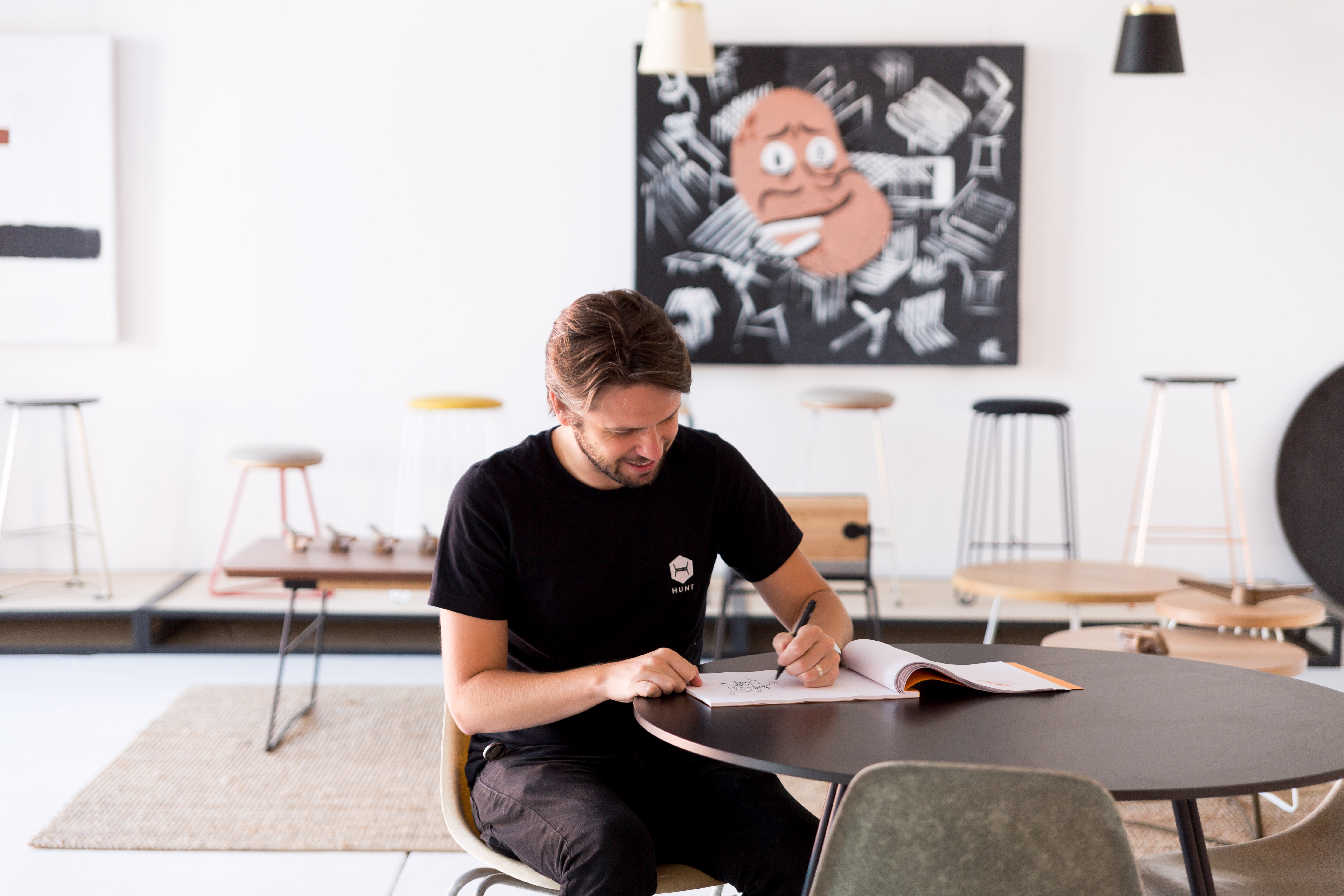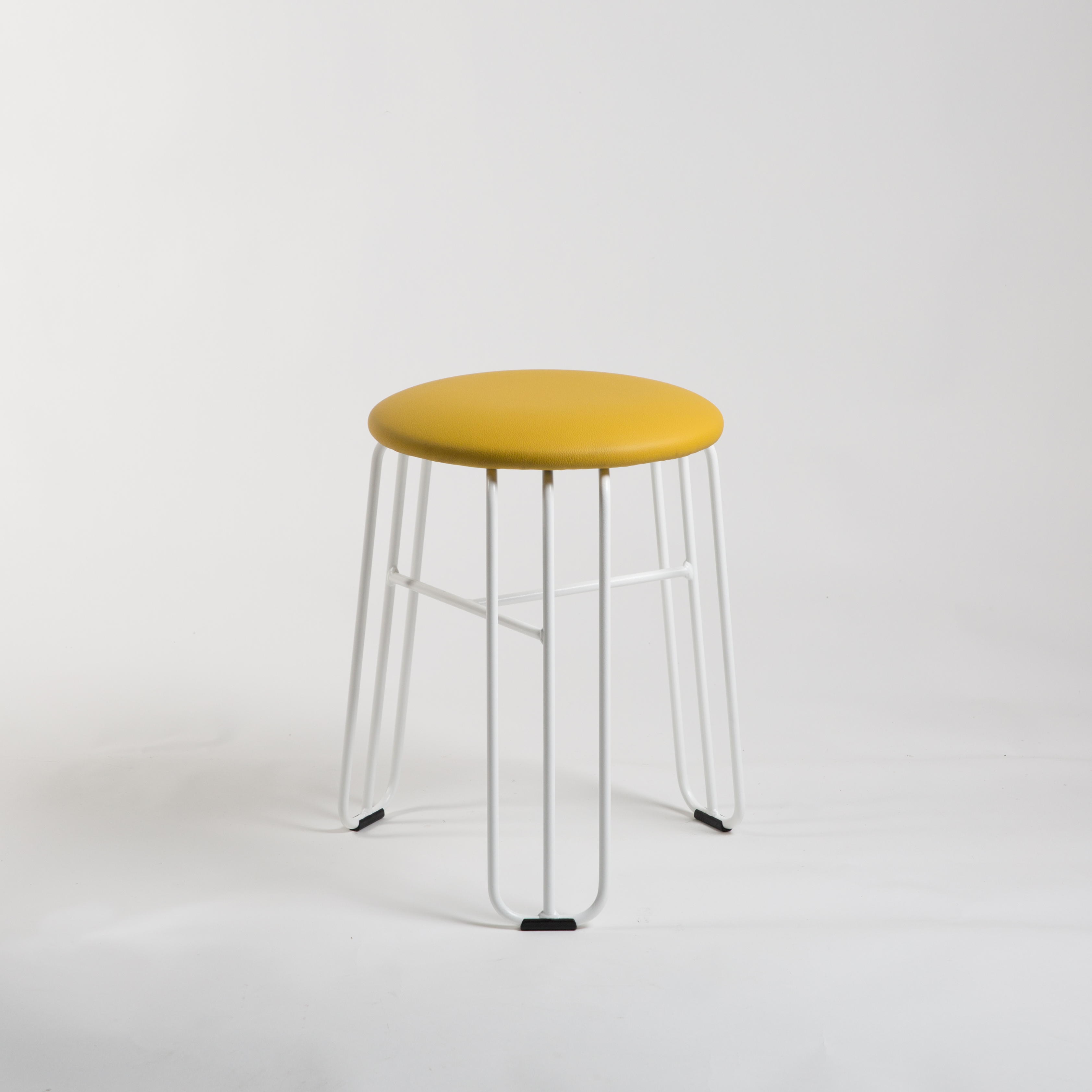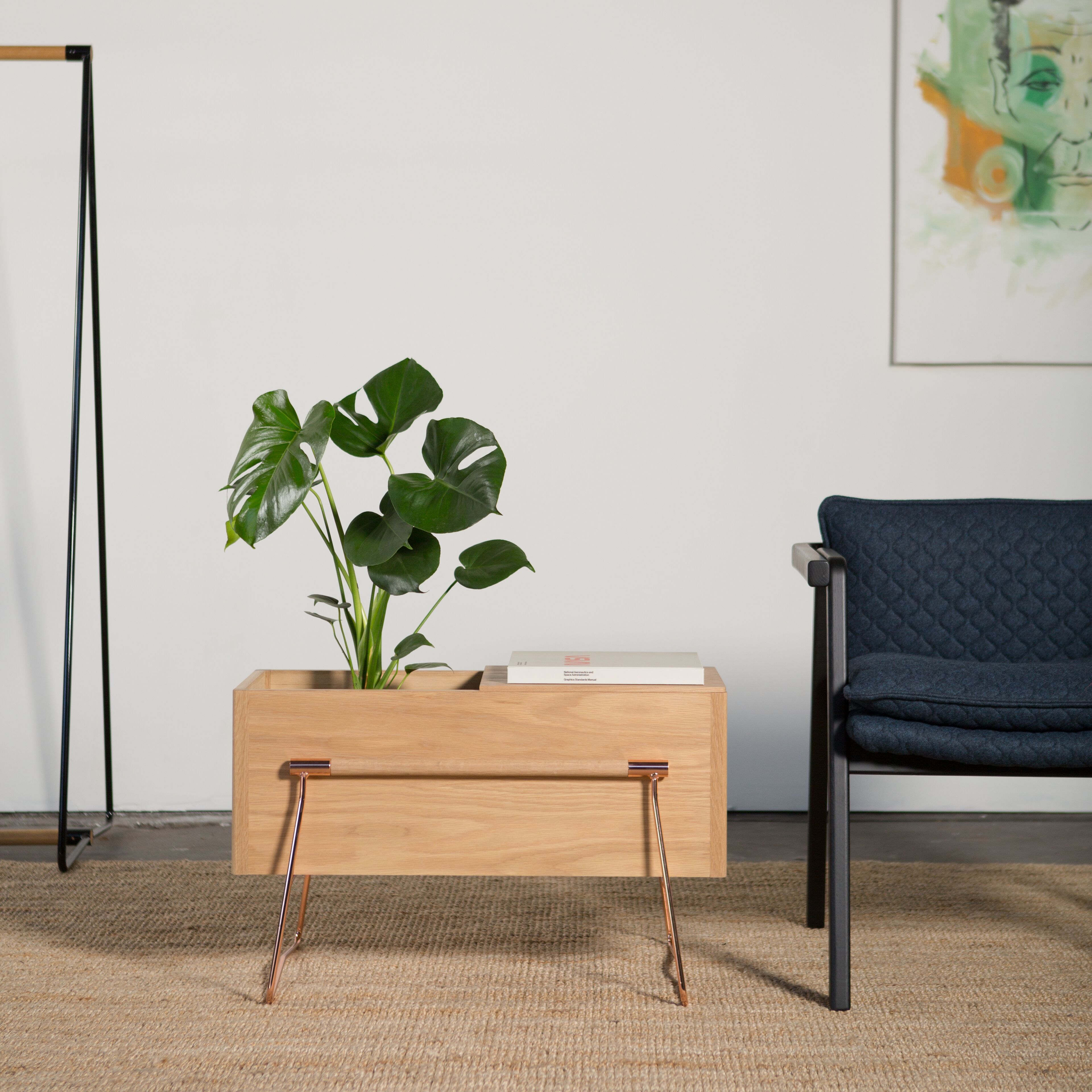Max Hunt UniSA Alumni Spotlight
The Bachelor of Design (Product Design) and the Master of Design (Industrial Design) programs at the University of South Australia are practical degrees that equip students with the skill set needed to design and create products that people use every day, such as electronic devices, domestic appliances, and homewares, sports equipment, toys, furniture and more.
Tertiary study in product and industrial design can lead to a range of careers across design disciplines. We spoke to one graduate of the program, Max Hunt of Hunt Furniture, about the complexities of emerging in a field characterised by rapid technological development.

Max Hunt in the studio. Image: supplied
When Max graduated from what was then called the product innovation program at UniSA in 2011, he had hopes of practicing as an industrial designer. Things didn’t quite go to plan – but the success and ubiquity of Max’s business, Hunt Furniture, since its inception soon after graduation, speaks for itself.
“Initially I thought I’d be a pure industrial designer who designed a little furniture, but I ended up the other way around,” says Max. “I decided to continue to push through with self-initiated projects until something worked. Expect nothing but the unexpected.”
Though often dismissed in terms of career opportunities, Max sees South Australia as a prime destination for furniture design thanks to its long history of craftsmanship that has resulted in irreplaceable expertise.
It is true that South Australia has a rich history of local knowledge in furniture design and manufacture. Many staples of the mid-century modern – for some, the golden era of Australian design – were locally design and made. National players T.H Brown, Leo Conci and E.R Noblett all called Adelaide home. Small to medium generational manufacturers thrived, and demand for these pieces steadily grew. A fascination with this influential era in South Australian design persists – original modernist pieces that carry the T.H Brown or Noblett seal are a staple for vintage stores, second-hand sellers, and collectors, and fetch a high price for their notoriety.
Looking to more recent history, it also explored how the contemporary market was shaped, and how local conditions drove changes in the strategies used to produce pieces. New manufacturing techniques emerged, facilitating unique combinations of industry production and hand-finishing, and mirroring concurrent architectural developments in a melding of disciplines that would come to characterise 21st century design trends. In South Australia, these strategies have survived better than elsewhere.
“We have an amazing wealth of manufacturing knowledge right here and we are very competitively priced,’ says Max. “South Australia should be a destination for designers all over Australia to make their products.”
A relative newcomer to the scene, Hunt Furniture has operated for almost a decade on a philosophy of original design, local craftsmanship and collaboration. Born in the UK and immigrating to Australia as child, Max’s early interests in art and design led to his pursuing industrial design. He began working at a furniture retailer, moving to an electrical drafting job after university and eventually moving on to manage Hunt Furniture full-time. These days, Max’s recognisably modern pieces are a feature of many local fit outs across Adelaide, as well as interstate and international applications.

ST500 bedside table. Image: supplied

HR1600 garment rack. Image: supplied
Max cites influences far and wide, emphasising the importance of taking inspiration from outside of your discipline: “I can’t just focus on one part of design. I like it all … the big goal is to establish a multidisciplinary studio. Keep it interesting.”
Hunt Furniture is known for authentic, original design and affordable prices that reflect the craftsmanship of each piece. Much of the changing of the South Australian furniture manufacturing industry was set in motion long before Hunt Furniture came into its own, so Max’s goal is to build on the legacy and utilise the wealth of knowledge at his fingertips.
For many designers, finding a balance between high quality, authentic design and affordability presents a major challenge. When asked about the future of furniture design, Max points to Australia’s rising problem with imitation and replica products as the design industry’s major contemporary dilemma.
“It seems crazy that the laws around copyright and intellectual property that apply to a photographer or artist don’t apply to design … [corporations] should be held accountable for ripping off so many designers.”
Like so many other designers and makers, Max has felt the effects of the replica industry. Still known to some as the Hunt stool thanks to its success, the HS650 was inspired by the classic workshop stool found in sheds and studios across Australia. It was one of Hunt Furniture’s earliest successes and one that put the burgeoning brand on the map. In 2015, after approaching Hunt Furniture at a design fair in Melbourne, a major retailer released a near-exact replica of the HS650 for a fraction of the cost. Sales of the original product quickly tapered off, and Max was informed by legal aid that his design was not covered by intellectual property law.
It’s unfortunately a story that is all too familiar for designers, sellers and makers across Australia. In 2010, discontent with the state of Australian intellection property law led to the creation of the Authentic Design Alliance, an organisation that has campaigned heavily against the practice with a renewed focus in the last few years. Despite a growing trend towards ethical and local consumption in some parts of the community in recent years, Max says this shift is not being felt at the base level that needs it most, and government response remains minimal:
“There needs to be a change in the law … if we can’t change the protection for designers, price always wins. Not many people want to buy something for $300 from a designer if people mistake it for a $25 stool from Kmart.”
With this in mind, Max’s advice for new students, recent graduates, and emerging creatives wondering how to navigate the minefield is simple but clear.
“Start designing and making and the rest will fall into place. Don’t quit your day job if you don’t have to. Build things people want. Learn new ideas. Pay yourself first. Be obsessed.
Be authentic.”

Bang Bang, hand cast bronze door knocker. Image: supplied

NS450 stool. Image: supplied


98 comments
I never thought I’d see my $420,000 in crypto again after scammers stole it, but Maestro Encrypter Financier turned my despair into disbelief. Losing my hard-earned money felt like a nightmare—years of savings gone in an instant. I was crushed and convinced it was lost forever. Then I found Maestro Encrypter Financier, a team of experts dedicated to recovering stolen cryptocurrency, and everything changed. From my first call, their professionalism and empathy stood out. They listened to my story, assured me they could help, and outlined a clear plan. Their team used cutting-edge encryption techniques and a masterful grasp of blockchain technology to outsmart the scammers. They bypassed every security trick the thieves had set up, tracking down my funds with precision and speed. What amazed me most was how fast they delivered. In just a few weeks, I got the unbelievable news: my $420,000 was back in my account. The relief was indescribable—like a massive burden lifted off my chest. I couldn’t stop smiling, overwhelmed with gratitude for their skill and dedication. Maestro Encrypter Financier didn’t just recover my money; they gave me back my peace of mind. Their service is exceptional, and their results speak for themselves. If scammers have taken your crypto, don’t lose hope—reach out to them. They’re not just a recovery service; they’re a lifeline for anyone hit by crypto fraud. I’m beyond thankful and can’t recommend them enough. Thanks to Maestro Encrypter Financier, I’m whole again, and my faith in justice is restored. They’re the real deal! .For enquiry, Email:(maestroencrypter@financier.com) or call/ WhatsApp: +1 472 203 8937
It started with a dream—a dream of financial independence, of escaping the grind and securing a future for my family. Like many others, I was drawn to the world of cryptocurrency. The stories of people striking it rich with Bitcoin were everywhere, and I thought, why not me? That’s when I stumbled upon an online investment platform promising astronomical returns. I invested a substantial amount of my savings, believing I was on the path to financial freedom.But within weeks, everything fell apart. The platform vanished overnight. Emails bounced back, phone numbers were disconnected, and my funds were gone. I felt like I had been hit by a truck. The weight of my mistake was crushing I had not only lost my savings but also jeopardized my family’s future. I was drowning in guilt, anger, and despair, unsure of where to turn.That’s when I found Washington Recovery Pro. At first, I was skeptical. How could anyone recover money from anonymous Bitcoin scammers? But I was desperate, and I decided to give them a shot,from the moment I reached out, Washington Recovery Pro was different. They listened to my story with genuine empathy and assured me that they had helped countless others in my situation.They specialized in tracing cryptocurrency transactions, uncovering the identities of scammers, and working with international authorities to recover stolen funds. Their transparency gave me hope. Finally, the breakthrough came. They had traced my funds to a series of wallets and identified the individuals behind the scam. Through their network of legal and law enforcement partners, they initiated a recovery process.The day I received the news that a significant portion of my funds had been recovered was one of the happiest of my life. Washington Recovery Pro had not only given me back my money but also restored my faith in justice.Reach out to them Via..
Email~WashingtonRecoveryPro@engineer.com
WhatsApp ~+1 (903) 249‑8633
Telegram ~https://t.me/Washingtonrecoverypro
When I realized I had been duped by a phishing scam and lost my Bitcoin, I was devastated. The sum was significant, and I felt utterly helpless. I tried a couple of other firms, but they were either too vague about the process or made unrealistic promises. Washington Recovery Pro, on the other hand, was different from the start. Their team was professional, transparent, and incredibly responsive. They didn’t make any promises they couldn’t keep but instead gave me a clear, realistic assessment of what could be done. They were able to locate my Bitcoin through a combination of on-chain forensics and tracking methods. The entire process took about two weeks, but it was worth every second. My Bitcoin was successfully recovered, and I can’t stress enough how professional and diligent the Washington Recovery Pro team was. If you’ve lost Bitcoin to fraud or other issues, trust Washington Recovery Pro to get it back. They are without a doubt the best in the field. Send or visit the site via:
Email- WashingtonRecoveryPro@engineer.comWhatsApp- +1 (903) 249‑8633
Telegram- https://t.me/Washingtonrecoverypro
When I realized I had been duped by a phishing scam and lost my Bitcoin, I was devastated. The sum was significant, and I felt utterly helpless. I tried a couple of other firms, but they were either too vague about the process or made unrealistic promises. Washington Recovery Pro, on the other hand, was different from the start. Their team was professional, transparent, and incredibly responsive. They didn’t make any promises they couldn’t keep but instead gave me a clear, realistic assessment of what could be done. They were able to locate my Bitcoin through a combination of on-chain forensics and tracking methods. The entire process took about two weeks, but it was worth every second. My Bitcoin was successfully recovered, and I can’t stress enough how professional and diligent the Washington Recovery Pro team was. If you’ve lost Bitcoin to fraud or other issues, trust Washington Recovery Pro to get it back. They are without a doubt the best in the field. Send or visit the site via:
Email- WashingtonRecoveryPro@engineer.comWhatsApp- +1 (903) 249‑8633
Telegram- https://t.me/Washingtonrecoverypro
Reisepässe online kaufen, WhatsApp +49 175 2158756 US-amerikanische Reisepässe, Chinesischen Reisepass kaufen, Kanadischen Reisepass kaufen, Legale biometrische Reisepässe,
Reisepässe für Großbritannien/Europa/China/die Ukraine, US-Reisepass kaufen, in der Datenbank registrierte australische Reisepässe kaufen, Reisepässe zu verkaufen, wo kann ich einen Reisepass bekommen? Kaufen Sie einen Hongkong-Ausweis und löschen Sie Strafregister online.
WhatsApp……49 175 2158756
WhatsApp……https://wa.link/oemn4w
WEBSITE:……..https://documenthelps.com/
https://documenthelps.com/buy-usa-passport-online/
https://documenthelps.com/pass-online-kaufen/
https://documenthelps.com/buy-drivers-license-online/
https://documenthelps.com/zertifikat-online-kaufen/
https://documenthelps.com/id-cards-online-kaufen/
https://notfallzertifikate.com/shop/
E-Mail:…………support@documenthelps.com
Kaufen Sie TOEFL, IELTS, TOEIC, kaufen Sie kanadischen TEF, kaufen Sie kanadischen TCF, CELPIP, Celta-Zertifikat, Aufenthaltserlaubnis, kanadischen Wohnsitz, wandern Sie direkt nach Kanada ein, kaufen Sie Führerschein, Personalausweis, US-Greencard, Staatsbürgerschaft, kaufen Sie Sozialversicherungsnummer, SSN, Arbeitserlaubnis, erhalten Sie einen neuen Personalausweis, eine Sozialversicherungskarte, NIN, SIN, Heiratsurkunde, Geburtsurkunde. Bestellen Sie online das GoetheC1-Zertifikat zum Verkauf, erhalten Sie ein echtes Goethe C1-Zertifikat online in Hamburg, erhalten Sie ein validiertes Goethe C1-Zertifikat in der Schweiz, kaufen Sie deutsche Goethe C1-Zertifikate, erhalten Sie ein originales Goethe C1-Zertifikat online, kaufen Sie das Goethe C1-Zertifikat online, Goethe C1-Zertifikat online, benötigen Sie ein Goethe C1-Zertifikat ohne Prüfung, kaufen Sie ein Goethe A1-Zertifikat ohne Prüfungen in Berlin
Möchten Sie ein zweites Leben mit einer neuen Identität beginnen? Ihre Privatsphäre schützen, eine neue Kreditauskunft erstellen, strafrechtliche Überprüfungen umgehen und Ihre Freiheit zurückgewinnen?
WhatsApp……49 175 2158756
WhatsApp……https://wa.link/oemn4w
WEBSITE:……..https://documenthelps.com/
https://documenthelps.com/buy-usa-passport-online/
https://documenthelps.com/pass-online-kaufen/
https://documenthelps.com/buy-drivers-license-online/
https://documenthelps.com/zertifikat-online-kaufen/
https://documenthelps.com/id-cards-online-kaufen/
https://notfallzertifikate.com/shop/
E-Mail:…………support@documenthelps.com
Kaufen Sie Falschgeld online, chemische SSD-Lösung, Aktivierung.
Unser Unternehmen verfügt über langjährige Erfahrung in der Herstellung gefälschter Reisepässe und anderer Ausweisdokumente. Wir verwenden hochwertige Geräte und Materialien zur Herstellung gefälschter Reisepässe. Wir replizieren sorgfältig alle geheimen Merkmale echter Reisepässe für unsere gefälschten Dokumente. Wir sind der beste Hersteller hochwertiger gefälschter Ausweise.
Wir liefern chemische SSD-Lösungen und 99,999 % reines flüssiges rotes Quecksilber zum Verkauf. WhatsApp: 49 175 2158756. Wir sind auf die Reinigung aller Arten von entstellten Banknoten, schwarzen Banknoten, mit Luftpolsterfolie versehenen, gestempelten, markierten oder befleckten Banknoten spezialisiert, z. B. schwarze Dollar, Pfund, Rand, Euro und alle Arten von chemischen SSD-Lösungen zum Reinigen von entstellten Banknoten. Wir schmelzen und reaktivieren gefrorene Chemikalien und bieten Reinigungsdienste für Windschutzrechnungen an. Die SSD-Lösung ist in ihrer gesamten Produktpalette die BESTE CHEMIKALIE auf dem Markt zum Reinigen von Anti-Breeze-Banknoten, entwertetem Geld und markierten Banknoten. Sie werden von der Aktivierungskraft und Schnelligkeit dieser CHEMIKALIE überrascht sein.
WhatsApp……49 175 2158756
WhatsApp……https://wa.link/oemn4w
WEBSITE:……..https://documenthelps.com/
https://documenthelps.com/buy-usa-passport-online/
https://documenthelps.com/pass-online-kaufen/
https://documenthelps.com/buy-drivers-license-online/
https://documenthelps.com/zertifikat-online-kaufen/
https://documenthelps.com/id-cards-online-kaufen/
https://notfallzertifikate.com/shop/
E-Mail:…………support@documenthelps.com